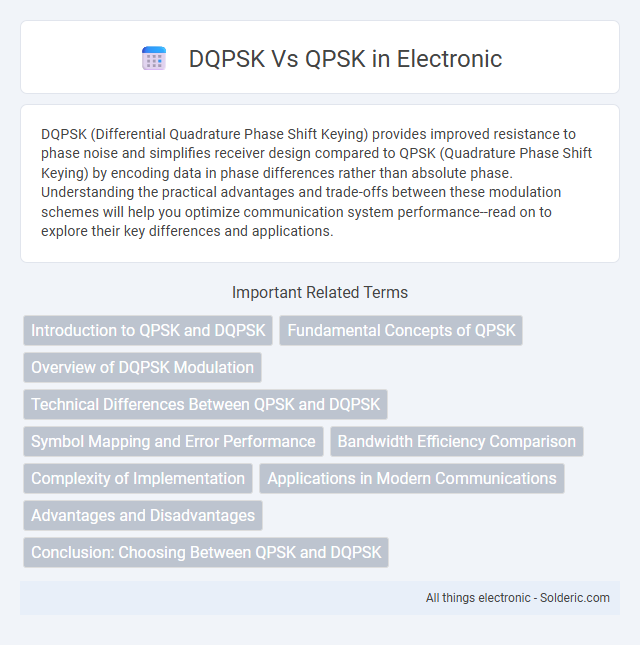DQPSK (Differential Quadrature Phase Shift Keying) provides improved resistance to phase noise and simplifies receiver design compared to QPSK (Quadrature Phase Shift Keying) by encoding data in phase differences rather than absolute phase. Understanding the practical advantages and trade-offs between these modulation schemes will help you optimize communication system performance--read on to explore their key differences and applications.
Comparison Table
| Feature | DQPSK (Differential Quadrature Phase Shift Keying) | QPSK (Quadrature Phase Shift Keying) |
|---|---|---|
| Modulation Type | Differential phase modulation | Coherent phase modulation |
| Phase Reference | Relative phase difference between symbols | Absolute phase reference required |
| Receiver Complexity | Lower, no need for carrier phase recovery | Higher, requires carrier synchronization |
| Noise Sensitivity | More robust to phase noise | More sensitive to phase noise |
| Error Performance | Slightly higher bit error rate (BER) | Lower bit error rate (BER) |
| Typical Applications | Mobile communications, optical fiber systems | Satellite, wireless LANs, digital TV |
| Bandwidth Efficiency | Equal to QPSK | Efficient spectral usage |
Introduction to QPSK and DQPSK
QPSK (Quadrature Phase Shift Keying) modulates data by changing the phase of the carrier wave among four distinct states, enabling efficient transmission of two bits per symbol. DQPSK (Differential Quadrature Phase Shift Keying) improves upon QPSK by encoding data based on the phase difference between consecutive symbols, reducing the impact of phase ambiguity and simplifying receiver design. Understanding these modulation schemes helps optimize your communication system for robustness and spectral efficiency.
Fundamental Concepts of QPSK
QPSK (Quadrature Phase Shift Keying) encodes data by shifting the carrier wave's phase among four distinct states, each representing two bits, which effectively doubles the data rate compared to BPSK. In contrast, DQPSK (Differential QPSK) encodes data based on the difference between successive phases, enhancing resilience to phase ambiguity and making it suitable for scenarios with rapid phase changes or less coherent detection. Understanding the fundamental concepts of QPSK, including its use of orthogonal basis functions and phase modulation, is essential for optimizing Your communication system's spectral efficiency and error performance.
Overview of DQPSK Modulation
Differential Quadrature Phase Shift Keying (DQPSK) is a modulation technique that encodes data by comparing the phase difference between successive symbols rather than the absolute phase, offering improved resilience to phase noise and frequency offsets compared to QPSK. DQPSK simplifies receiver design by eliminating the need for complex carrier phase recovery, making it highly suitable for wireless and optical communication systems where channel conditions can be challenging. Your choice of DQPSK can enhance system robustness, especially in environments with rapid phase variations or Doppler shifts.
Technical Differences Between QPSK and DQPSK
QPSK (Quadrature Phase Shift Keying) encodes data by changing the phase of the carrier signal in four distinct states, each representing two bits, enabling high spectral efficiency. DQPSK (Differential Quadrature Phase Shift Keying) differs by encoding data based on the phase difference between successive symbols, which enhances robustness against phase ambiguity and reduces the need for complex phase synchronization. Your choice between these modulation schemes depends on system requirements, with DQPSK offering improved performance in environments where phase tracking is challenging.
Symbol Mapping and Error Performance
DQPSK employs differential encoding in symbol mapping, enabling phase changes between consecutive symbols to represent data, which simplifies carrier phase recovery and reduces phase ambiguity compared to QPSK's absolute phase mapping. In terms of error performance, QPSK generally achieves a lower bit error rate (BER) under ideal coherent detection due to its direct symbol reference, while DQPSK experiences a slight performance degradation stemming from error propagation in differential decoding. The trade-off favors DQPSK in scenarios with rapid phase variations, as its robustness to phase noise and simpler receiver design can outweigh its marginal increase in BER.
Bandwidth Efficiency Comparison
DQPSK (Differential Quadrature Phase Shift Keying) enhances bandwidth efficiency by encoding data through phase differences, eliminating the need for a coherent reference signal and reducing spectral overhead compared to QPSK (Quadrature Phase Shift Keying). Both schemes utilize four phase states for modulation, but DQPSK's differential encoding effectively improves resistance to phase noise and allows for more bandwidth-efficient communication in dispersive channels. In scenarios where phase synchronization is challenging, DQPSK maintains higher spectral efficiency while delivering comparable data rates to QPSK.
Complexity of Implementation
Differential Quadrature Phase Shift Keying (DQPSK) simplifies receiver design by eliminating the need for complex carrier phase synchronization required in Quadrature Phase Shift Keying (QPSK). This reduction in synchronization complexity leads to lower hardware and computational demands, making DQPSK more suitable for systems with limited processing capabilities. However, the differential encoding in DQPSK introduces slight performance degradation compared to QPSK, balancing complexity with signal quality.
Applications in Modern Communications
DQPSK and QPSK are widely used in modern communications for their efficiency in data transmission over bandwidth-limited channels. QPSK is commonly applied in satellite communication and wireless LANs due to its simplicity and robustness, while DQPSK is favored in optical communication systems and mobile networks for reducing phase ambiguity and improving signal integrity. Your choice between DQPSK and QPSK depends on system requirements like error performance, complexity, and channel conditions.
Advantages and Disadvantages
DQPSK offers improved spectral efficiency and better resilience to phase noise compared to QPSK, making it suitable for high-speed optical communication systems. However, its complexity increases the cost and power consumption of the transmitter and receiver. Your choice between DQPSK and QPSK will depend on balancing performance benefits against hardware implementation challenges.
Conclusion: Choosing Between QPSK and DQPSK
Choosing between QPSK and DQPSK depends on your system requirements for complexity, bandwidth efficiency, and resilience to phase noise. QPSK offers higher spectral efficiency and straightforward implementation but is more susceptible to phase ambiguity, while DQPSK provides improved robustness to rapid phase changes without requiring a coherent phase reference. For applications prioritizing reduced receiver complexity and better performance in fading environments, DQPSK is often the preferred choice, whereas QPSK excels in scenarios demanding maximum data throughput.
DQPSK vs QPSK Infographic

 solderic.com
solderic.com